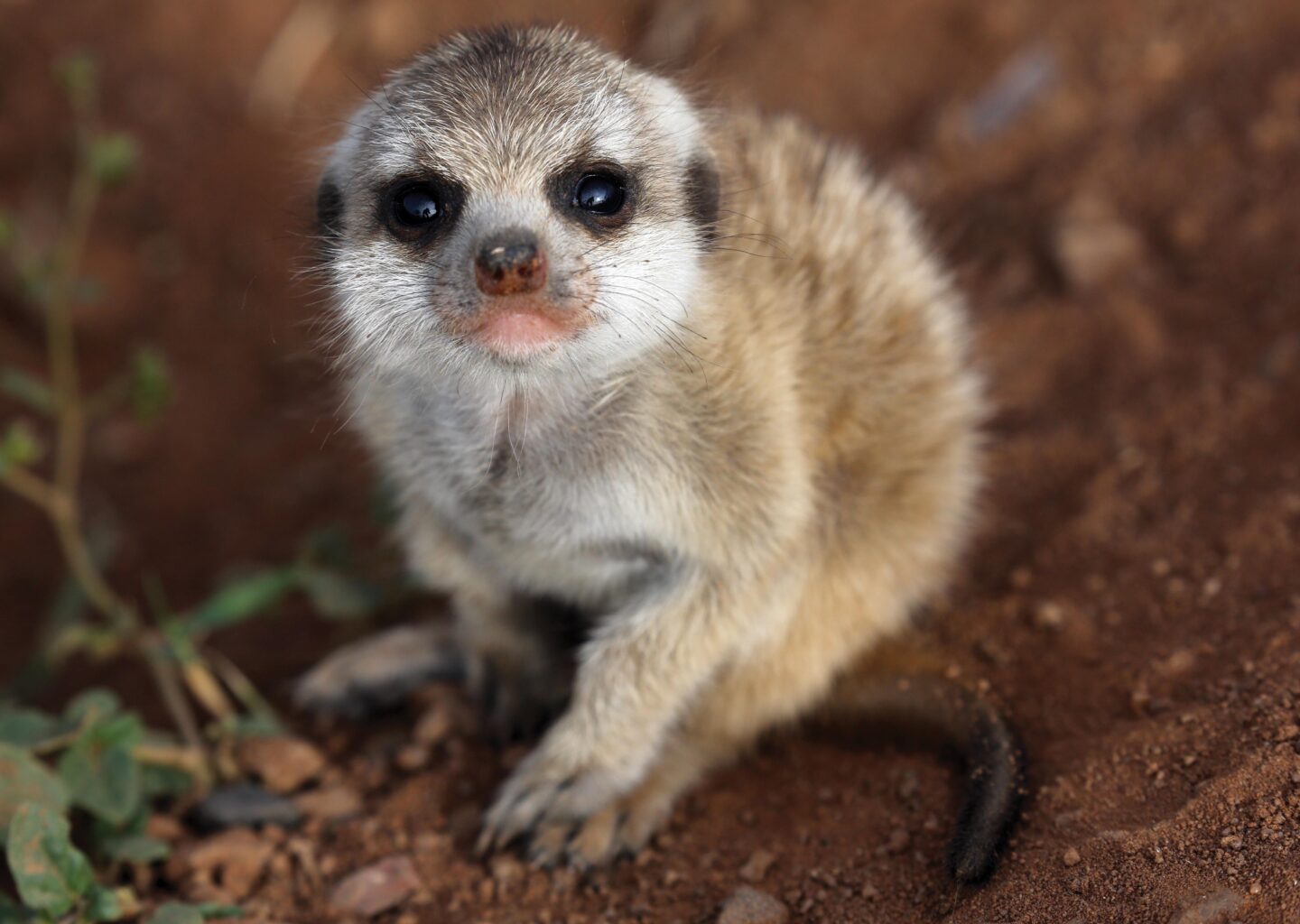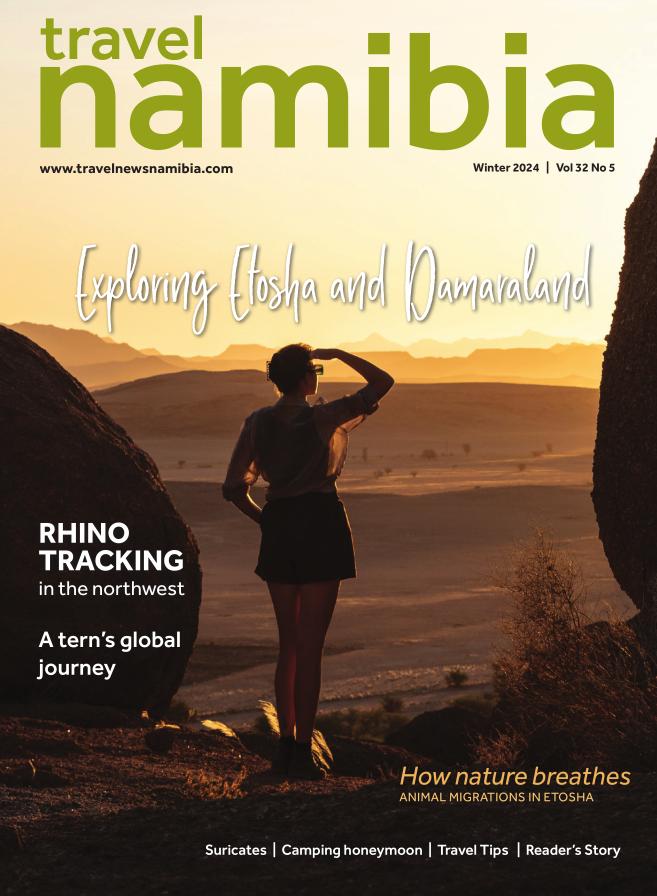

Suricates
nature's highly social little guards that are too cute for their own good
Standing on its hind legs, keeping balance with the help of its tail, and holding its front legs together against its chest and stomach, the little mammal scans the open grassland and the blue sky. Suddenly its eyes are fixed on something high above. It takes me some time to spot the small black silhouette high up in the sky, which turns out to be a vulture gliding across the firmament. Yet no alarm call sends the other members of the group scrambling for safety. The little guard seems to know that this silhouette does not mean danger.
Text Dirk Heinrich | Photographs Dirk Heinrich
From the Winter 2024 issue
Suricates are known in Namibia as “stoksterte” (Afrikaans for “sticktails”) because they hold their thin tails straight up when danger lurks or when they dash together as a group to or from their burrows. They sleep and give birth to their young in underground holes and tunnels, but during the day they forage in the adjacent landscape. At sunrise, they appear at the entrances and sit in the first sun rays to wake and warm up. Suricates live in groups of around 30 members; some of which will always be on guard duty. They take turns to watch the surrounding area and the sky for danger, warning the others by sounding different alarm calls if a predator is sighted. The alarm call for aerial danger, such as an eagle or a hawk, is different to the alarm call for terrestrial danger, such as a jackal, leopard or snake.
Suricates are a southern African mongoose species only found in South Africa, Botswana and Namibia and might also occur in a very small area in the southwestern corner of Angola. The carnivore atlas also shows an absence in the coastal areas of southern Namibia. According to the late Mike Griffin, who was the Ministry of Environment, Forestry and Tourism’s expert on small mammals, reptiles and amphibians for 32 years, there were six groups of suricates that even live on and close to the beach in the Dorob National Park. I once saw a group on the beach just north of Wlotzkasbaken.
Their sharp and curved foreclaws are adapted for digging. They feed on beetles, eggs, frogs, arthropods, reptiles, birds, plants and seeds. Suricates are known to also feed on scorpions, to whose venom they seem to be immune. The body of these little mammals is between 24 and 35 cm long and they weigh less than a kilogram. They dig their own burrows but also take over the burrows of ground squirrels and yellow mongooses. Often they are neighbours and I have seen a family of suricates live together with ground squirrels and yellow mongooses. Above ground, they kept their distance from each other and there was no aggression between the species. How they avoided each other below ground and who was where at night is anyone’s guess.
Because humans regard them as cute, they have become an attraction in many zoos across the world. They are not threatened in their desert and arid habitats and are listed as “least concern” on the IUCN Red List. People like to keep them as pets, which is illegal in Namibia, except with a permit from the Ministry of Environment, Forestry and Tourism. Nobody is allowed to remove an animal from the wild without a permit. Suricates are highly social animals and keeping single individuals is like keeping somebody in solitary confinement. Suricates kept as pets can be very aggressive towards humans and can inflict serious bites.
In a group, only the dominant pair breeds and the entire group cares for the offspring. Brothers and sisters never mate and need to move off to find a partner to start a new group. If one partner of the dominant pair is killed or dies, the remaining partner needs to find a new partner from outside to mate again. When two groups meet each other at the boundaries of their territories, there will be a show of strength and if the opponents are not impressed, fierce fighting with injuries and even death could be the result.
Individuals who have lost their group have difficulty being accepted by another group. It takes time and perseverance to eventually become a member of the new family. Within a group, everybody cares for one another. Everybody babysits, does guard duty and keeps close contact with the other members – especially during the early morning and late afternoon at the burrow. Scent marking is very important, not only to mark the territory but to ensure that each member of the group carries a common odour.
When foraging in the vicinity of their burrow, there is constant vocal contact between the group members who are either on guard or foraging too. Once the youngsters are old enough to join the group outside the burrows, each has a babysitter who teaches the youngster how to find food, handle the prey and react to alarm calls. Food items are generally not shared, except by babysitters looking after the youngsters. TN
- This is the irresistible face that unfortunately has people taking suricates away from their mothers and the rest of the group to raise them as pets. This is illegal and the worst thing that can happen to such a little creature.
- In the early morning, suricates sit or stand at their burrow facing the sun to warm up before getting ready to start the day and go foraging.
- About three weeks after birth the youngsters come out of the burrow for the first time and start to investigate the surrounding area under the watchful eyes of their babysitters.
- The young of the dominant pair are looked after by all members of the group. These are often their older siblings.
- There is a lot of playing and quarrelling going on within the group when they are at the burrow before or after foraging.
- Dominant males and females can be aggressive towards intruders, other animals and possible danger.
- The dominant female of the group is lying on her back, suckling her four babies. While she cares for the young, she is off duty from any other group activities.
- One group member is working while three are on guard (or, one is working and three are watching). They move a lot of material at the burrow, but when looking for food they do not dig very deep.
- Suricates seem to be immune to scorpion venom and chew off the scorpion’s tail first. Once they have killed their prey, they turn their back to the others to finish off the meal without sharing. Sometimes a member tries to steal a piece but is chased away vocally and pushed aside.
- All members of a group stick together and on cold winter mornings or evenings, they cuddle together at the burrow entrances before either foraging or going underground for the night.
- The joys of motherhood – The dominant female, the only one in the group which gives birth, is relaxing near an entrance to the burrow and suckling her young. The rest of the group is nearby, some on guard duty while others are foraging.






